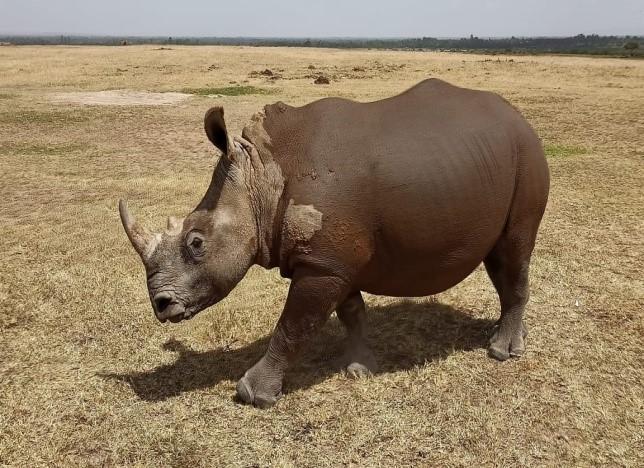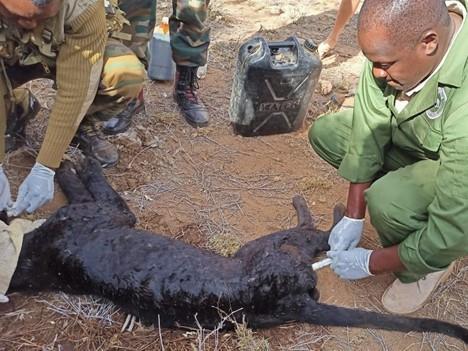SWT/KWS MT. KENYA MOBILE VETERINARY UNIT


JANUARY 2023




JANUARY 2023

14 Cases in January
January Report by Dr. Jeremiah Poghon
7 Rhino Cases
2 Elephant Cases
In January 2023, the Mt. Kenya Mobile Wildlife Veterinary Unit attended to all reported wildlife emergency cases that required urgent veterinary intervention in Laikipia ecosystem and Mt. Kenya region. The Unit attended to 14 cases in total, these comprised 7 rhino cases, 2 elephant cases, 1 giraffe case, 1 buffalo case, 1 leopard case and 2 mountain bongo cases.
We greatly appreciate the Sheldrick Wildlife Trust (SWT) for its continued support that has enabled the Mt. Kenya Mobile Veterinary Unit to respond promptly to wildlife emergencies and offer lifesaving treatment


January 2023


The Northern White Rhino has been declared as “possibly extinct in the wild” with the last remaining individuals, Najin and Fatu, being kept in captivity at the Ol Pejeta Conservancy.

The two females cannot have a viable pregnancy due to health and age-related problems. Najin, the older female, has a large ovarian tumour and has very weak hind legs while Fatu developed untreatable endometriosis which makes her uterus a hostile environment for embryo implantation. An in-depth ethical risk assessment led to the team deciding to retire the older of the two remaining females, 32-year-old Najin, as a donor of egg cells leaving Fatu as the sole eligible oocytes donor.
In a bid to save the northern white species from extinction there was need to recruit surrogates into the program. A team of scientists embarked on performing a successful embryo transfer in one of the southern white surrogates (Curra) after retiring the two initial surrogates (Ariemet and Mojo) from the program.
Curra, one of the southern white rhino surrogates, successfully underwent embryo transfer.
The Solio Conservancy team reported an adult male black rhino that was limping.


The rhino was darted with 4.5 mgs Etorphine and 80 mgs Azaperone on the left shoulder muscles. The drug took effect after 5 minutes with the animal in left lateral recumbency, it was then physically restrained. Treatment and anaesthesia monitoring were done simultaneously. 10 mgs Butorphanol was given intravenously, and Oxygen supplementation was also administered for optimal breathing. The rhino had good body condition; multiple lacerated wounds were observed on the neck and chest region, and the affected right front limb had a soft tissue injury The wounds were sprayed with Oxytetracycline then 15,000 mgs Amoxicillin was administered as antibiotic cover and 3,000 mgs Flunixin meglumine was given as antiinflammatory cover.
The rhino has a good prognosis.
This adult male buffalo was reported to have been kneeling for an extended period, it was reported to be emaciated.
The buffalo was darted from a vehicle with 7 mgs Etorphine and 80 mgs Azaperone. The dart landed on the right rump muscles, and the drugs took effect 5 minutes later with the buffalo in left lateral recumbency. It was physically restrained thereafter. Treatment and anaesthesia monitoring were done simultaneously. The buffalo was observed to be in poor body condition, and it appeared emaciated. 20 mls B12 was administered intramuscularly to cater for any mineral deficiencies and 5 mls Ivermectin was injected subcutaneously as an anthelmintic.

The buffalo has a good prognosis.
An adult male reticulated giraffe with a snare around its right hind limb was reported The Mt Kenya Mobile Veterinary Unit responded and intervened as described below.
The giraffe was darted from a vehicle with 15 mgs Etorphine; the dart landed on the left neck muscles, and the drug took effect 5 minutes later with the animal in left lateral recumbency. Treatment anaesthesia monitoring were done simultaneously. The wire snare around the giraffe’s right hind limb was removed. Luckily, there were no visible injuries inflicted by the snare. 4,500 mgs Amoxicillin and 400 mgs Dexamethasone were administered intramuscularly then anaesthesia was reversed with 300 mgs Naltrexone injected via the jugular vein.

The giraffe has a good prognosis.
The Mt Kenya Mobile Veterinary Unit was informed about a male elephant calf (approx. 2.5 – year old) abandoned in the Loldiaga Hills.
The calf was darted with 1 mgs Etorphine on the left rump. The drug took effect 6 minutes later with the calf in left lateral recumbency
The calf was observed to be in good body condition. 80 mgs Azaperone was administered intramuscularly, after which the calf was translocated by caravan to the Sheldrick Wildlife Trust Nairobi Nursery while alert, and under close monitoring of vital parameters. The calf was released at the nursery in good health.

An adult male white rhino carcass was reported to have been found in a river within the park. The Mt. Kenya Veterinary Unit carried out an autopsy to determine the cause of death.

The rhino had deep laceration wounds on the perineal area, and deep puncture wound on the left neck area that had severed the jugular, oesophagus and the trachea leading to massive blood loss. Blood was observed in the stomach and the lungs.

The rhino died from hypovolemic shock caused by massive blood loos after a territorial fight with another rhino bull.
Ruto, a male mountain bongo, was reported to be limping due to a cracked hoof.

Ruto was approached on foot and darted with 6 mgs Etorphine and 30 mgs Azaperone The dart landed on the left rump muscles, and the drugs took effect 5 minutes post-darting. Ruto went down on right lateral recumbency then he was physically restrained. Treatment and anaesthesia monitoring were done simultaneously, and Oxygen supplementation was administered for optimal breathing. Ruto was observed to be in good body condition, he had a cracked hoof on the right front limb which was causing pain in the surrounding soft tissues. Ruto also had overgrown hooves. 1,000 mgs Flunixine meglumine, 3,000 mgs Amoxicillin and 20 mls Catasol were administered intramuscularly. The injured hoof was debrided with Hydrogen peroxide and flushed with Iodine then sprayed with Oxytetracycline. The overgrown hooves were then trimmed with a hoof trimmer. Anaesthesia was reversed thereafter with 7 mgs Naltrexone; 50 mgs was injected intramuscularly while 25 mgs was administered via the jugular vein. Ruto rose 2 minutes postreversal.
Ruto has a good prognosis
The Ol Pejeta conservancy team reported an adult male white rhino that was limping.


The rhino was darted from a vehicle with 4.5 mgs Etorphine and 80 mgs Azaperone. The dart landed on the rump, and the drug took effect 8 minutes post-darting with the animal in left lateral recumbency. The rhino was physically restrained after it attempted to stand. Treatment and anaesthesia monitoring were done simultaneously. 10 mgs Butorphanol was given intravenously, and oxygen supplementation was also administered for optimal breathing. The rhino was in good body condition. A shallow puncture wound was observed on the right thigh and the affected right hind limb had a soft tissue injury. Antibiotics and antiinflammatories were administered accordingly and a topical anti-bacterial applied.
The rhino has a good prognosis.
The Solio ranch team reported a female white rhino (approx. 5 years old) that was limping


The rhino was darted on the shoulder muscle with 4 mgs Etorphine and 70 mgs Azaperone. The drugs took effect after 7 minutes with the animal in sternal recumbency. The rhino was physically restrained then 10 mgs Butorphanol IV and oxygen supplementation were administered for optimal breathing. The rhino was in good body condition. The right front limb that was found to have soft tissue injuries and was treated with antibiotics and Flunixin meglumine.
The rhino has a good prognosis
The Solio ranch team also reported another female white rhino (approx. 3 years old) that was lame The Mt. Kenya Veterinary Unit treated the lame rhino immediately after attending to case 8.


The rhino was darted from a vehicle with 3 mgs Etorphine and 60 mgs Azaperone. The dart landed on the rump, and the drugs took effect after 5 minutes with the animal in lateral recumbency. The rhino was physically restrained then 10 mgs Butorphanol IV and oxygen supplementation were administered for optimal breathing. The rhino was in good body condition The lame left front limb was examined and found to have soft tissue injuries suffered during a territorial fight. The rhino was treated with antibiotics and Flunixin meglumine.
The rhino has a good prognosis
An adult male black leopard was reported to be exhibiting unusual behaviour, the leopard had no interest in hunting, it was also slightly emaciated, and it had engorged ticks all over the body.

The leopard was darted from a vehicle with 150 mgs Ketamine (100mgs/ml) and 2 mgs Medetomidine (40mg/ml). The dart landed on the right shoulder. Sample collection, biometrics and anaesthesia monitoring were done simultaneously. The leopard was observed to be slightly emaciated, and it had engorged ticks all over the body. Its initial temperature was elevated at 40.4⁰C. 900 mgs Amoxicillin, 10 mgs Dexamethasone, and 5 mls vitamin B12 were administered intramuscularly while 10 mgs Ivermectin was injected subcutaneously. Blood samples were collected from the femoral vein for EDTA and serum analysis. Ticks, whiskers, and tissue samples were also collected and stored in ethanol for further analysis. Anaesthesia was reversed with 10 mgs Atipamazole administered intramuscularly an hour after darting. The animal rose 15 minutes post-reversal.
The leopard has a good prognosis.
An adult elephant bull was found dead in one of the community farms near the park. The Meru National Park team reported the case to the Mt. Kenya Mobile Veterinary Unit that carried out an autopsy to determine the cause of death.
Significant Post-mortem findings

▪ A laceration was observed on the skin at the point of entry of the weapon.
▪ Feed was present in the peritoneal cavity.
▪ The peritoneal cavity was filled with blood.
Cause of death
▪ Puncture of vital organs including the spleen and heart which resulted in internal bleeding and hypovolaemic shock.
▪ Possible poisoning from the suspected arrow wound.
A sub adult female mountain bongo called Mars was reported to have a swelling on the right jaw.

Mars was immobilized with 3 mgs Etorphine and 30 mgs Azaperone. The dart landed on the right rump, and the drug took effect after 5 minutes. Mars went down on left lateral recumbency, she was placed in sternal recumbency and physically restrained. Treatment and anaesthesia monitoring were done simultaneously, and Oxygen supplementation was administered for optimal breathing. Mars was observed to be in good body condition, she had an abscess on the right jaw that was filled with pus. 2,000 mgs Phenylbutazone, 1,500 mgs Amoxicillin and 10 mls Catasol were administered intramuscularly. The abscess was lanced, pus drained, and the pocket debrided with Hydrogen peroxide. It was then flushed with Iodine, filled with Opticlox ointment, sealed with green clay paste and sprayed with Oxytetracycline. Anaesthesia was reversed thereafter with 100 mgs Naltrexone; 50 mgs was administered intramuscularly while 50 mgs was injected via the jugular vein. Mars rose 2 minutes post-reversal.
Mars has a good prognosis.
An adult male black rhino carcass was reported to have been found floating at a water point within the conservancy. The Mt Kenya Veterinary Unit carried out a post-mortem to determine the cause of death.

▪
▪ The animal had a body condition score of 2.5/5 and had reduced muscle mass all over the body.
▪ There was no evidence of external injuries.
▪ There was evidence of absence of coronary fat.
▪ The lungs were found to have developed a dark red colour.
▪ The lungs were found to be firm in consistency, and they also had froth in the bronchi and bronchioles.
The rhino drowned.